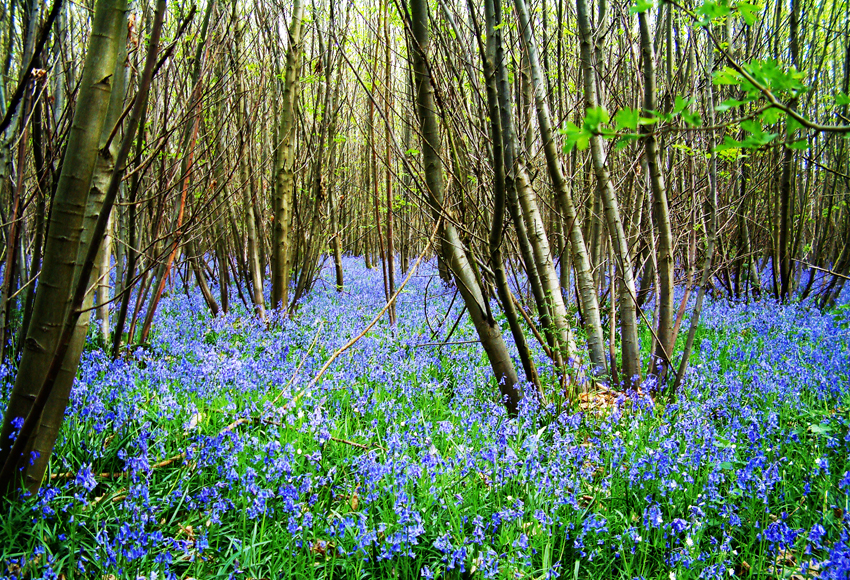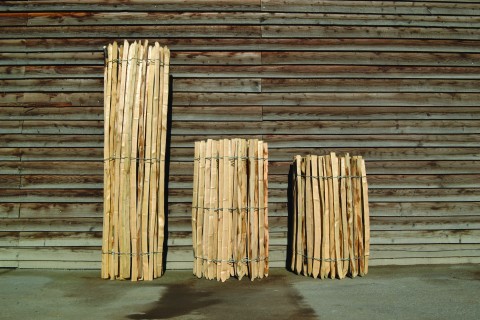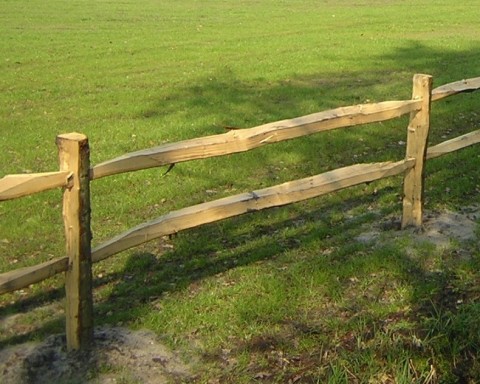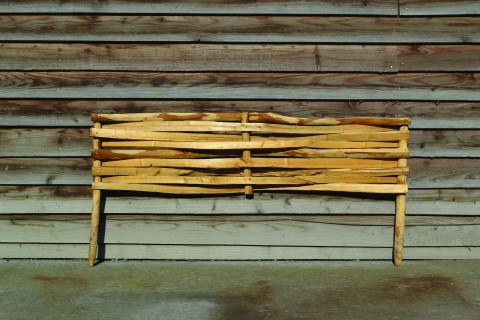Anyone encountering the ancient art of chestnut coppicing for the first time must wonder why a great swathe of woodland has apparently been wantonly chopped down. Aren’t we meant to be protecting forests and woodland at home as well as in far flung exotic climes? The answer is that coppicing is an ancient woodland management custom stretching back to Neolithic man which is both eminently efficient and desirable. Trees are cut down to just above ground level, the stumps grew new shoots and in a few years the cycle can begin all over again.

Bluebells growing in woods near Torry Hill
Along with oast houses, fruit orchards and tile hung cottages, chestnut coppicing is one of the most distinctive characteristics of Kent on the North Downs. It is inextricably linked with the history of hop growing in the county. Hops were first introduced from north Germany or Russia in the 16th-century with the first hop garden recorded near Canterbury in 1520. Chestnut was traditionally used for making the hop poles. By 1835 the hop acreage in Kent was approximately 25,000 acres rising to 46,000 acres by 1878.
Located in an old chalk pit in Doddington, a few miles from Faversham, is Torry Hill Chestnut Fencing, http://torryhill.co.uk/the largest producer of wholesale chestnut paling in the British Isles.

Hand-crafted chestnut paling using cleft chestnut pales wired up with high quality galvanised wire. Chestnut is full of natural tannins and lasts well in the ground as well as strong and difficult to climb over. It is increasingly been used for dune restoration projects.
It is a flourishing enterprise set up by John Leigh-Pemberton selling a wide range of products hand made from Castanea Sativa, the sweet chestnut as well as woodchip made from mixed broadleaves. Sheep hurdles, panel fencing, border panels, gates, post and rail fencing, chestnut paling fencing are just some of the items available. The word pale originates in the park pales that surrounded medieval deer parks.

Rolls of pale fencing. Wired chestnut fencing was probably first introduced in the early 20th century
Sweet chestnut timber is very durable and resistant to rot. It cleaves or splits easily along the grain making it an ideal choice for pegs, stake or fencing. Sweet chestnut flourishes in a Mediterranean climate, this explains why coppicing is traditionally a southern practice. It is too cold in the North of England.

Smart post and rail fencing constructed with split lengths of chestnut slotted horizontally into morticed posts. It is robust enough to contain horses and cattle. It is sometimes referred to as ‘Sussex Rail’. It should last for 30 or 40 years.
John’s family have owned Torry Hill Farm for more than a century and have been exemplary custodians of a 1,000 acres of woodland practicing traditional chestnut coppicing. ‘Our business offers a sustainable green product and is the equivalent of a Landrover – a quality hand crafted English product. There is no wastage, bent lengths are chipped for woodchip. We will sell more than 2,000 tons of woodchip this year and 3,000 tons of wood. Holland, Belgium and Germany account for 70% of the turnover. We sell 1,000 gates a year to one Belgian supplier. England lags behind much of Europe in its green consciousness’. Torry Hill supplied eight and half miles of chestnut fencing and posts to the Olympic village in 2010. It is often used on film sets.

Woven chestnut panels designed for edging borders or constructing raised beds in gardens. Available in sizes up to 1.7m long.
Wandering around the extensive yard between the piles of chestnut logs it is salutary to think back a few years. ‘In the late 90s the industry was in the doldrums, the Sittingbourne paperworks (the paper pulp industry used the knotty or twisted poles that did not split easily) had shut and there was no value in timber’ says John Leigh-Pemberton’. But I realised that if the chestnut woods were not coppiced it was a question of killing the golden goose. if the necessary rotation to the whole process was abandoned the industry would die.’ At the time there were a few one man businesses selling coppiced wood, but they couldn’t afford to stockpile timber to sell in huge quantities to fencing manufacturers.
Happily in 2008 John bought a local timber business based in the nearby village, Rodmersham, as a going concern. It had 3 employees. The business grew very very fast doubling its turnover for the first three years. Nearly a decade on 40 people are employed, some as subcontractors. John is passionate about training young people keeping the craft of coppicing and cleaving or splitting the wood by hand alive. He also points out that coppicing is also extraordinarily good environmentally as it provides an ‘ideal habitat for song birds, insects and flowers. I have even seen Heath Fritillaries, a rare type of butterfly’.
Torry Hill Chestnut Fencing, The Chalk Pit, Lade Wood Hill, Doddington, Kent ME9 OED
Text: Amicia. Photographs: Torry Hill Chestnut Fencing. Photograph of bluebells: Lisa.